(All rights belong to their owners. Images used here for review purposes only.)
Bravely Default, from Square Enix, 2012, Grade: B+
According to the wiki entry, Bravely Default was originally intended as a sequel to Final Fantasy: The 4 Heroes of Light, obviously indicating that it was produced by the team that worked on at least one of the FF games. It was released in Japan in 2012 under the title Bravely Default: Flying Fairy. An expanded version of the game followed in 2013 for Japan, Europe and Australia, and 2014 for North America. I bought my copy of Flying Fairy used from Book Off for 500 yen ($4.50 USD). At that price, it's a good deal.
The story follows 4 heroes, Tiz, Agnes, Ringabel and Edea (the U.S. version's English names) as they try to save their world. Tiz starts out as a farm boy living in the village of Norende. One day, the village is destroyed by a pillar of light, leaving a massive crater in the ground, and killing Tiz's younger brother. He is soon joined by Agnes, the priestess of the Wind Crystal, whose temple had been destroyed. She wants to activate all 4 crystals (Wind, Water, Fire and Earth) and Tiz accompanies her as a bodyguard. Ringabel wants in on the adventure, and Edea switches sides from the group trying to stop the activation of the crystals, and ends up fighting against her own father and friends. Agnes found a pendant associated with a fairy named Airy, and Airy then leads the group to each of the crystals, and guides Agnes in powering them up. Along the way, the group faces various villains working on behalf of Edea's father, and when each one is defeated, the you gain access to a new job skill. Eventually, the 4 crystals are indeed activated, and Airy takes the heroes to the Pillar of Light, which presumably will let them go to a new world where the crater never opened up. However...
Bravely Default is a big game. There's a lot to do in it, and it's easy to put in at least 100 hours on it. The world map is gorgeous, and each continent has a crystal tower, several dungeons, and a town where you can interact with the inhabitants and go through a variety of storylines. The artwork is great, the story has a major plot twist in the middle, and the music is good. Unfortunately, as with almost all RPGs, 90% of the items, magic and job skills are unnecessary to finishing the game. They're just filler. The maps have houses you can't enter, and the dungeons have 3-4 monsters that get recycled over and over again. The map has a huge ocean in the middle, but only two locations you can visit.
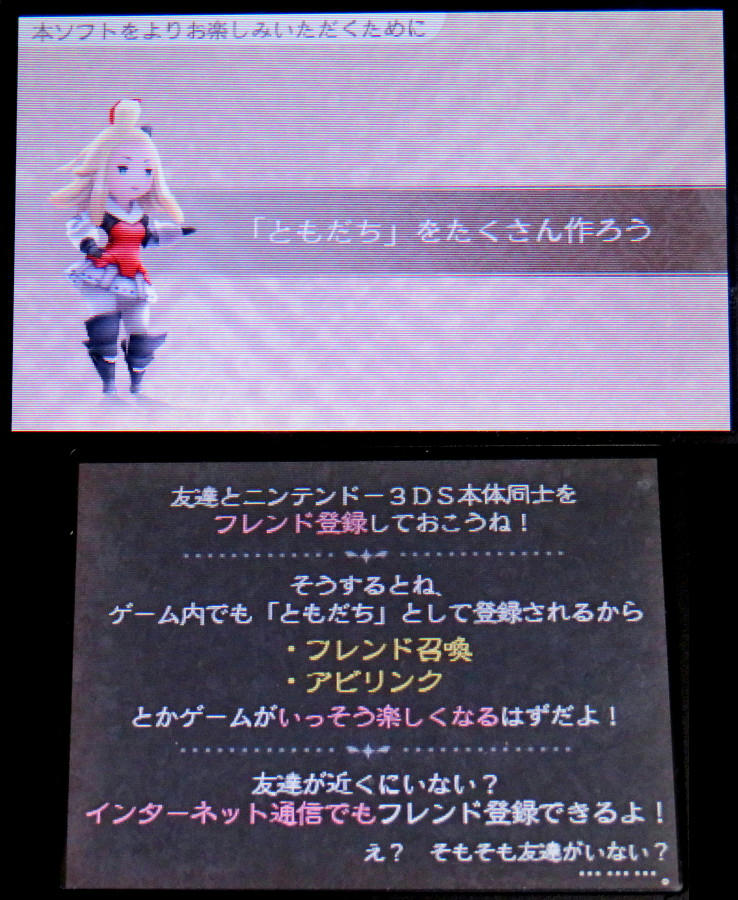
(The opening screen encourages you to make lots of friends.)
One of the more interesting aspects of Bravely Default is the fighting system, which is where the game's name comes from. It's a turn-based system, where you set the actions for your four characters, and when you're done with the fourth one, the battle runs automatically for that turn, with the characters and enemy taking their actions in semi-random order based on a hidden "initiative" score assigned to each one That is, even if your party all have the same Speed scores, sometimes Tiz will act first followed by Agnes, and sometimes Edea goes first followed by a monster, and then by Agnes and then Tiz. The actions include Attack, Ability, Brave, Default, Item and Escape. Attack is a physical attack with the equipped weapon. Ability allows you to select a skill associated with the two Jobs that the character has chosen for it. Brave lets you take up to 3 extra moves in that round, but the penalty is that you'll have to wait an equal number of rounds afterward before being able act again (called BP). Default makes the character guard for that round, adding 1 to their BP score. Item lets them use an item in inventory, or activate a power associated with the equipped weapon, and Escape is just that - a percentage-based chance of getting out of the battle.
Generally, your characters start the battle with 0 BP (battle points). Selecting Brave subtracts 1 from BP, up to 4 moves total for that round. Default adds 1 to BP. If you just attack or use an item in that turn, BP remains at 0. After your characters all take their moves for the round, 1 is added to BP (unless you simply attacked or used an item, in which BP stays at 0). If BP is negative at the start of the next round, that character can't act. This is important, in that some enemies can steal BP from your characters, making them go negative and losing a turn. On the other hand, one job skill lets your characters give each other extra BP, and another skill adds 1 BP at the start of every turn. The point is that you can finish a battle faster if all your characters take 4 moves per round each, but that can leave you extremely vulnerable for the next 3 rounds if you fail to kill the monster and then have to just stand there helplessly as the monster gets 3 free rounds against you.
At the end of each battle, you get Exp., PG and JP for the party, which is naturally based on the difficulty of the battle. Exp. is experience for going up in base level, with a cap at level 99. Your character's base stats (attack, physical defense, magical attack, magical defense, speed and evasion) all go up with each level bump. PG is the game's version of money, and is one of the easiest things to come by in the game. I finished the game with 7.6 million pg, and there's really nothing to spend it on, even when using the Merchant job class (the Merchant can use PG for attacking the enemy, and defending themselves). JP is Job Points, which allows your character to go up in Job levels, with a cap at job level 14.
Leveling up is unbalanced, both for regular levels, and for jobs. The first few levels take 100-300 exp. to go to the next one, but when you reach level 80 or so, it's something like a fixed 70,000 exp. per level, and you can easily get 12,000 exp. per battle if you know where to look. I hit the level cap of 99 by chapter 5 of the game, and there's 8 chapters, plus two endings and one optional dungeon.
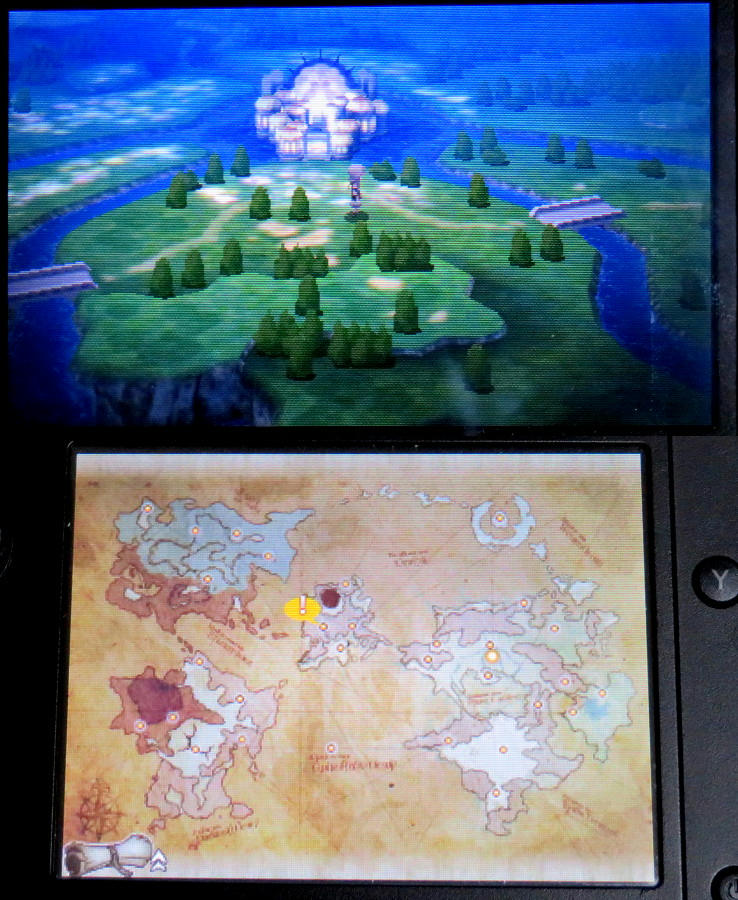
(World map, with one of the towns visible on the top screen.)
So, with no need to gain more exp. after chapter 5, why keep playing so long, and amass so much money? Well, that's where the job asterisks come it. Your characters start the game as Freelancers. The Freelancer is an all-round generic job class that is equally good with all weapons, and armor. It's not outstanding with any one thing, but has the benefit of being able to avoid triggering traps in the dungeon. As you defeat each boss, you get access to their Job Class. That is, beating the White Mage gives you the White Mage asterisk (i.e. - it unlocks that job class for you), and defeating the Vampire gives you the Vampire asterisk. There are a total of 24 jobs, and each one has 14 skills, special moves, or status improvements that alter your base level stats. Mages (White, Black, Red, Time) subtract from physical attack and add to magical attack, while also changing your weapons affinities. Knight and Templar boost physical stats at the cost of magical ones, etc. To go from job level 1 to 9 requires a total of about 2,800 JP, then to go from 9 to 10 costs 3,500 JP, and from 13 to 14 costs another 5,000 JP. Since most battles only net you 50-100 JP each, that's a LOT of churning if you want all 4 characters to reach level 14 on ALL 24 jobs (although, there is one area where the average is 200 JP per battle, and a couple special monsters can give you 600 JP at one time if you do it right). So, yeah, I did a lot of churning, which is why my exp. levels capped at 99, and I amassed so much money. Even so, I didn't finish the job leveling up until the end of Chapter 8.
All of the English walkthroughs are for the expanded game, so it's easy for me to tell what got changed in the remake from the original. 80% of the two games are the same, but the remake has a tutorial subquest system, which rewards you for completing the game tutorials (e.g. - you get a potion or something for the first time you open the Items menu during a battle, and some other item for learning how to switch weapons, etc.) And Chapter 7 has a completely different combination of bosses that fight you, which leads me to the next point.
--- Spoilers ---
In the story, Airy tries to send the party to another world where the chasm hasn't opened up, and she fails. 4 times. The first time, all the job asterisk-based subquests reset, so you can fight those bosses again, and you have to reactivate the crystals again, but things are a bit different from the first time through the world map. After that, you get in a loop. For the original game, chapters 6-8 are in the loop, and I was convinced that I'd done something wrong that was preventing the game from advancing. In the remake, chapter 7 moves the job quest bosses around to give you a lot of more challenging boss fights. There is a clue though, to show that you're playing the game right - each time you go through the pillar of light, the markings on Airy's wings changes (you can see Airy up close when you open the inventory window, or when you save the game). In chapter 8, the markings on her wings form the number "0". After that, going through the pillar again takes you to the end game.
Otherwise, the only other differences between the two versions of the game are that certain bosses are a little tougher or have slightly higher HP levels in the remake. But, with all the tutorial subquest rewards, you can afford better weapons and more healing items earlier in the game.
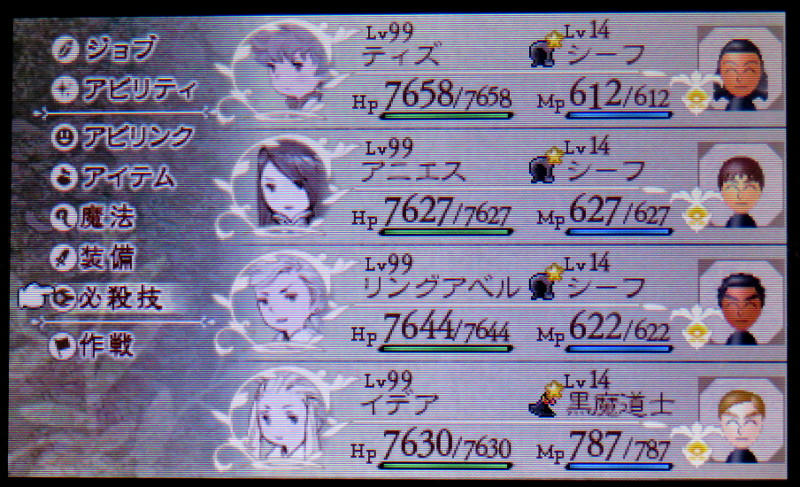
(Main menu screen. From top left, Job, Ability, Abilink, Item, Use Magic, Equip Gear, Set Up Special Attacks, and Config. Abilink lets you use your friends' characters as an attack summons.)
One of the ideas I really like in Bravely Default is that one of the job classes (Conjurer) has a skill that you can assign to one of your characters, called "Exterminate." When assigned, if your party gets initiative, at the start of the battle any enemies that are at least 20 levels below you will die without your having to fight them. THIS is what makes churning to level up all the jobs so much more acceptable (and faster).
You can assign two jobs to a party member at a time - the primary and the secondary jobs. The primary job is the one that goes up in level as you get JP from the battles. It modifies your base stats according to that class (the Knight has good physical attack and defense stats, but poor magical attack and defense) and gives you certain inherent boosts, such as increased success rates when trying to steal items as a Thief. The secondary job lets you use the actions for that job that use MP (magic points) or BP (battle rounds). In this way, you can have a Knight that casts attack magic (Knight/Black Mage), or a Thief that can use Drain (Thief/Vampire). But, you have to be careful with how you do the pairings, because the Knight does have weak magic stats, so any attack magic you cast won't do as much damage to the enemy. It's better to just have a dedicated mage (White Mage/Time Mage combo), and then beef up a different character (as with the Templar/Pirate) and use the Pirate's skill of Taunt to get the enemy to focus on just the one character that has two shields and thus the highest defense stats in the party. Additionally, you can have up to 5 Support Skill Slots, which lets you use skills from other jobs that may be handy (White Mage has a skill that takes up 3 slots that is good for making attack magic stronger, while the Conjurer has that Exterminate skill for eliminating low-level enemies without having to actually fight them). So, the more job classes you've unlocked and bumped up to level 14 each, the more and better support skills you can assign to your party as you see fit (such as with the Templar/Pirate having Exterminate, and +20% to physical defense).
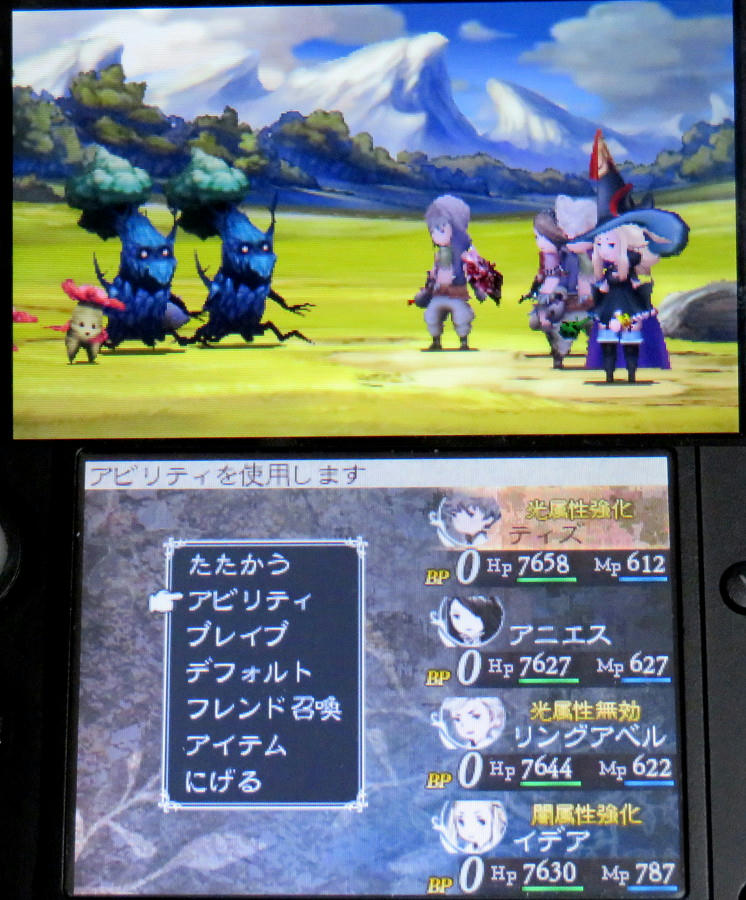
(Battle screen, fighting against ents and mandrakes.)
But, as I wrote above, Flying Fairy is unbalanced. It's too easy to cap out at level 99, and if you get more than 2 million pg there's really nothing to spend it on. If you beat the game, you can return to the point in Chapter 8 where you have to activate the crystals again, but keeping the money and items you find, or you can start a New Game+ (which I haven't tried yet, but after having unlocked all the optional bosses, I don't see a reason to do it all over again, even if I do get to keep my weapons and items. And assuming te original game has New Game+.)
One last thing, although it is actually one of the most important elements to the game. Bravely Default makes a big point about friendships. In part, this is to get you to talk your friends into buying their own copies of the game and sharing their game data with you. If you have access to the Square Enix web server, you can upload your character's stats and your friends, or complete strangers, can access them and "summon you" in a battle as a kind of "god summons." Which means, if you get really powerful, your character can be the deciding factor in whether your friends survive a tough boss battle. The problem is that the Bravely Default server apparently was taken down some time ago, and I can't access it now. This is a problem, if you look at Norende.
Norende is the village the Tiz lived in. After being destroyed, there's a mini-quest to rebuild it. You get a small village map, and several buildings, bridges and roads are marked as damaged. You have one villager that you can assign to rebuilding any one location. Each location, and up to 9 level ups for the buildings, require the worker to spend a fixed number of hours real-time to complete the repairs. You can't turn the 3DS game machine off, change the internal clock, and turn it back on to trick the game into thinking that much time has passed. The game has to be running for x hours, although it is ok to close the cover to let the machine "sleep." You just can't turn it off and expect the repairs to continue on their own. The first few repairs are manageable, in that they're only 1-5 hours long each. Towards the end though, the final repairs, to go from shop level 10 to 11 in the remake are 99 hours for each shop. (There are 10 shops, and the path to the best weapons power-ups requires an additional 99 hours to repair that.) However, if you trade game data with your friends, or if you uploaded your game data to the Square Enix server, you'd get extra villagers, maybe 1-3 every day, once a day after midnight. But, as I say, the Japanese webserver is no longer online, so I'm stuck with just the one village worker and at least a full month of repair work for him...
There's one more difference between the original game, and the remake, apparently. In the original, the first of the shops I finished repairing had a level cap at 10, but the walkthrough for the remake shows that that game goes to 11 on each shop. In some cases, the final level lets you buy some weapon that you can't buy from any other shop in the regular game, but in others you unlock secret costumes for your party members. As I say, I've finished the game and went into a continuation, and I'm currently letting the machine run on its own to try to unlock the higher shop levels. I want to see if the original version has the secret costumes available somewhere, or not. I'm thinking the answer is "not", but I'm not playing any other games right now, so the 3DS would just be sitting on the shelf, turned off at this point. I'm willing to pay for the electricity to keep recharging the battery for a few days. After that, I'll give up.
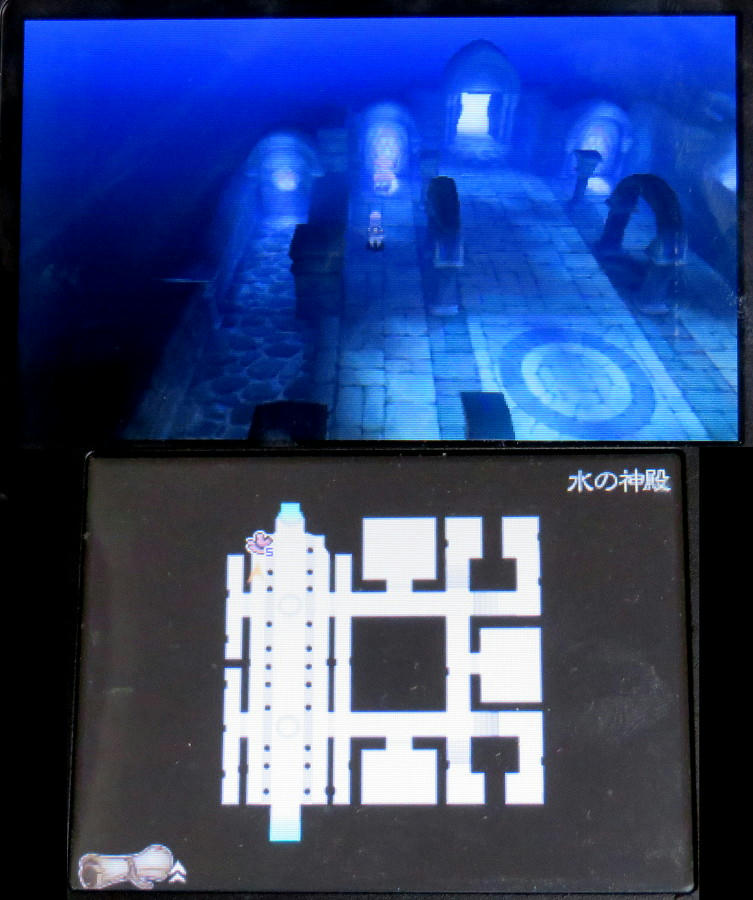
(Dungeon map. The figure barely visible in front of the window in the top screen is The Adventurer. He serves as the save point and mini-store in all of the dungeons, just before you reach the boss for that stage.)
Summary: Bravely Default: Flying Fairy, is a fun game, but it does have its flaws. The artwork and music are good, but the character designs are a bit childish and the gameplay is uneven. There is one remaining optional super-boss that I haven't been able to defeat, and fighting him is not fun at all. I've got all the best weapons, armor and job classes in the game, and I was still killed off in the first round of the battle. I'm not going to bother fighting him again. Likewise, the final story boss took much longer to beat than any of the other bosses, so fighting it again isn't that appealing. Otherwise, if you like the Final Fantasy universe, you may like this game as well. Recommended to those that like Japanese RPGs.
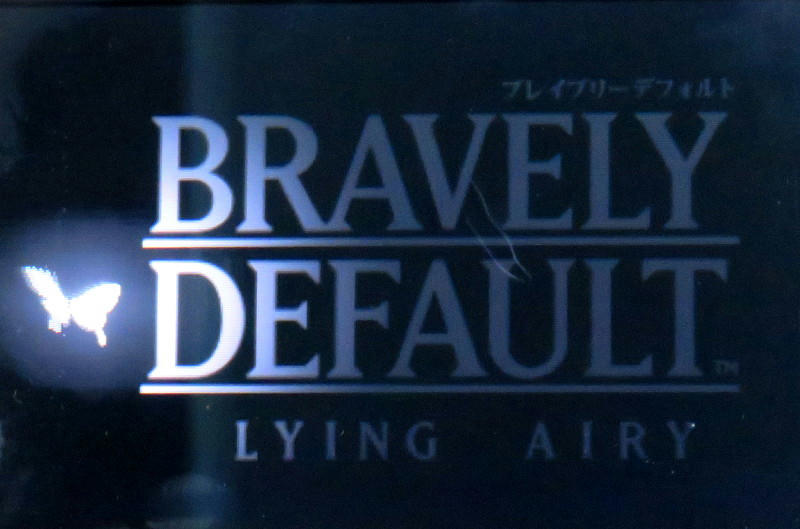




No comments:
Post a Comment